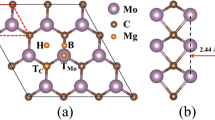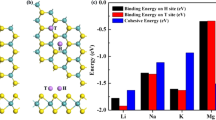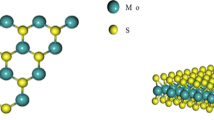Abstract
Given the potential availability, non-toxicity, and environmental acceptability of alternatives to lithium-ion batteries (LIBs), secondary batteries utilizing magnesium (Mg) ions have garnered significant attention. Numerous recent studies have focused on identifying suitable anode materials for post-lithium-ion batteries, particularly magnesium-ion batteries. In this regard, we carried out a theoretical study to investigate the 2D multiphase molybdenum disulphide (1T/2H MoS2) anode material using density functional theory (DFT) and ab initio molecular dynamics (AIMD) simulations. Our observations confirmed the efficacy of this material as an anode. The results highlight its exceptional stability, high binding energy, enhanced metallic characteristics following Mg adsorption, theoretical specific capacity, and remarkably low diffusion barriers. Notably, the anode material exhibits an ultralow energy barrier of 0.04 eV, surpassing that of extensively studied 2D materials. By employing a wide range of Mg2+ concentration during the charging process, we achieved a high specific capacity of 4496.77 mAh g−1 ions, coupled with an average operating voltage of 0.04 V. These findings provide valuable insights for the experimental design of exceptional anode materials.









Similar content being viewed by others
Data availability
N/A.
References
Behabtu HA et al (2020) A Review of Energy Storage Technologies’ Application Potentials in Renewable Energy Sources Grid Integration. Sustainability 12. https://doi.org/10.3390/su122410511
Su F et al (2020) Recent advances and challenges of two-dimensional materials for high-energy and high-power lithium-ion capacitors. Batter Supercaps 3(1):10–29
Megahed S, Scrosati B (1994) Lithium-ion rechargeable batteries. J Power Sources 51(1):79–104
Goodenough JB (2015) Energy storage materials: A perspective. Energy Storage Mater 1:158–161
Das CK et al (2018) Overview of energy storage systems in distribution networks: Placement, sizing, operation, and power quality. Renew Sustain Energy Rev 91:1205–1230
Niu J, Zhang Z, Aurbach D (2020) Alloy anode materials for rechargeable Mg Ion batteries. Adv Energy Mater 10(23):2000697
Guo Z et al (2020) Recent advances in rechargeable magnesium-based batteries for high-efficiency energy storage. Adv Energy Mater 10(21):1903591
Chang Z et al (2015) Hybrid system for rechargeable magnesium battery with high energy density. Sci Rep 5(1):11931
Aurbach D et al (2000) Prototype systems for rechargeable magnesium batteries. Nature 407(6805):724–727
Wang G et al (2022) Progress and perspective on rechargeable magnesium-ion batteries. Sci China Chem. https://doi.org/10.1007/s11426-022-1454-0
Mensing JP, Lomas T, Tuantranont A (2022) Advances in rechargeable magnesium batteries employing graphene-based materials. Carbon 197:264–281
Zhang J et al (2021) Current design strategies for rechargeable magnesium-based batteries. ACS Nano 15(10):15594–15624
Yang R et al (2021) Development and challenges of electrode materials for rechargeable Mg batteries. Energy Storage Mater 42:687–704
Dominko R et al (2020) Magnesium batteries: current picture and missing pieces of the puzzle. J Power Sources 478:229027
Peng L et al (2016) Two-dimensional materials for Beyond-Lithium-Ion batteries. Adv Energy Mater 6(11):1600025
Zhang Z et al (2018) MnSb2S4 monolayer as an anode material for Metal-Ion batteries. Chem Mater 30(10):3208–3214
Ye X-J et al (2019) Monolayer, bilayer, and heterostructure arsenene as potential anode materials for Magnesium-Ion batteries: a first-principles study. J Phys Chem C 123(25):15777–15786
Pham PV et al (2022) 2D heterostructures for ubiquitous electronics and optoelectronics: principles, opportunities, and challenges. Chem Rev 122(6):6514–6613
Mortazavi M et al (2014) Ab initio characterization of layered MoS2 as anode for sodium-ion batteries. J Power Sources 268:279–286
Lv X et al (2022) Dynamic 1T–2H mixed-phase MoS2 enables high-performance Li-Organosulfide battery. Small 18(1):2105071
Acerce M, Voiry D, Chhowalla M (2015) Metallic 1T phase MoS2 nanosheets as supercapacitor electrode materials. Nat Nanotechnol 10(4):313–318
Zhao W et al (2018) Metastable MoS2: crystal structure, electronic band structure, synthetic approach and intriguing physical properties. Chem Eur J 24(60):15942–15954
Chang K, Chen W (2011) In situ synthesis of MoS2/graphene nanosheet composites with extraordinarily high electrochemical performance for lithium ion batteries. Chem Commun 47(14):4252–4254
Lei Z et al (2018) Recent development of metallic (1T) phase of molybdenum disulfide for energy conversion and storage. Adv Energy Mater 8(19):1703482
Wang D et al (2017) Swollen ammoniated MoS2 with 1T/2H hybrid phases for high-rate electrochemical energy storage. ACS Sustain Chem Eng 5(3):2509–2515
Hou X et al (2022) Phase transformation of 1T′-MoS2 induced by electrochemical prelithiation for Lithium-Ion storage. ACS Appl Energy Mater 5(9):11292–11303
Fang X et al (2012) Lithium storage in commercial MoS2 in different potential ranges. Electrochim Acta 81:155–160
Wang L et al (2014) Atomic mechanism of dynamic electrochemical lithiation processes of MoS2 nanosheets. J Am Chem Soc 136(18):6693–6697
Ji X et al (2021) Interlayer coupling dependent discrete H → T′ phase transition in lithium intercalated bilayer molybdenum disulfide. ACS Nano 15(9):15039–15046
Namsheer K et al (2022) Rational design of selenium inserted 1T/2H mixed-phase molybdenum disulfide for energy storage and pollutant degradation applications. Nanotechnology 33(44):445703
Du X et al (2022) Anchoring 1T/2H MoS2 nanosheets on carbon nanofibers containing Si nanoparticles as a flexible anode for lithium–ion batteries. Mater Chem Front 6(23):3543–3554
Shu H et al (2016) The capacity fading mechanism and improvement of cycling stability in MoS2-based anode materials for lithium-ion batteries. Nanoscale 8(5):2918–2926
He X et al (2022) 1T-MoS2 monolayer as a promising anode material for (Li/Na/Mg)-ion batteries. Appl Surf Sci 584:152537
Li H et al (2022) Controllable fabrication and structure evolution of hierarchical 1T-MoS2 nanospheres for efficient hydrogen evolution. Green Energy Environ 7(2):314–323
Ejigu A et al (2017) A simple electrochemical route to metallic phase trilayer MoS2: evaluation as electrocatalysts and supercapacitors. J Mater Chem A 5(22):11316–11330
Kresse G, Furthmüller J (1996) Efficient iterative schemes for ab initio total-energy calculations using a plane-wave basis set. Phys Rev B 54(16):11169–11186
Kresse G, Furthmüller J (1996) Efficiency of ab-initio total energy calculations for metals and semiconductors using a plane-wave basis set. Comput Mater Sci 6(1):15–50
Perdew JP, Burke K, Ernzerhof M (1996) Generalized gradient approximation made simple. Phys Rev Lett 77(18):3865–3868
Kresse G, Joubert D (1999) From ultrasoft pseudopotentials to the projector augmented-wave method. Phys Rev B 59(3):1758–1775
Grimme S (2006) Semiempirical GGA-type density functional constructed with a long-range dispersion correction. J Comput Chem 27(15):1787–1799
Grimme S et al (2010) A consistent and accurate ab initio parametrization of density functional dispersion correction (DFT-D) for the 94 elements H-Pu. J Chem Phys 132(15):154104
Grimme S, Ehrlich S, Goerigk L (2011) Effect of the damping function in dispersion corrected density functional theory. J Comput Chem 32(7):1456–1465
Lalitha M, Nataraj Y, Lakshmipathi S (2016) Calcium decorated and doped phosphorene for gas adsorption. Appl Surf Sci 377:311–323
Lalitha M, Mahadevan SS, Lakshmipathi S (2017) Improved lithium adsorption in boron- and nitrogen-substituted graphene derivatives. J Mater Sci 52(2):815–831
Blöchl PE (1994) Projector augmented-wave method. Phys Rev B 50(24):17953–17979
Monkhorst HJ, Pack JD (1976) Special points for Brillouin-zone integrations. Phys Rev B 13(12):5188–5192
Henkelman G, Uberuaga BP, Jónsson H (2000) A climbing image nudged elastic band method for finding saddle points and minimum energy paths. J Chem Phys 113(22):9901–9904
Henkelman G, Jónsson H (2000) Improved tangent estimate in the nudged elastic band method for finding minimum energy paths and saddle points. J Chem Phys 113(22):9978–9985
Vikraman D et al (2021) Theoretical evaluation and experimental investigation of layered 2H/1T-phase MoS2 and its reduced graphene-oxide hybrids for hydrogen evolution reactions. J Alloy Compd 868:159272
Novais Antunes FP et al (2018) Van der Waals interactions and the properties of graphite and 2H-, 3R- and 1T-MoS2: A comparative study. Comput Mater Sci 152:146–150
Thomas S et al (2019) Two-dimensional haeckelite h567: A promising high capacity and fast Li diffusion anode material for lithium-ion batteries. Carbon 148:344–353
Barik G, Pal S (2019) Defect induced performance enhancement of monolayer MoS2 for Li- and Na-Ion batteries. J Phys Chem C 123(36):21852–21865
Mei T et al (2022) First-principles investigations to evaluate Mo2B monolayers as promising two-dimensional anode materials for Mg-ion batteries. J Phys: Energy 4(3):035002
Wang Y et al (2018) Metallic VO2 monolayer as an anode material for Li, Na, K, Mg or Ca ion storage: a first-principle study. RSC Adv 8(20):10848–10854
Mortazavi B et al (2017) Flat borophene films as anode materials for Mg, Na or Li-ion batteries with ultra high capacities: a first-principles study. Appl Mater Today 8:60–67
Thomas S, Madam AK, Zaeem MA (2020) Stone-wales defect induced performance improvement of BC3 monolayer for high capacity lithium-ion rechargeable battery anode applications. J Phys Chem C 124(11):5910–5919
Manju MS et al (2021) Mechanically robust, self-healing graphene like defective SiC: a prospective anode of Li-ion batteries. Appl Surf Sci 541:148417
Rajput K et al (2021) Ca2C MXene monolayer as a superior anode for metal-ion batteries. 2D Mater 8(3):035015
Khossossi N et al (2021) High-specific-capacity and high-performing Post-Lithium-Ion battery anode over 2D black arsenic phosphorus. ACS Appl Energy Mater 4(8):7900–7910
Wu D et al (2021) Reshaping two-dimensional MoS2 for superior magnesium-ion battery anodes. J Colloid Interface Sci 597:401–408
He X et al (2021) Theoretical studies of SiC van der Waals heterostructures as anodes of Li-ion batteries. Appl Surf Sci 563:150269
Shao Y et al (2014) Highly reversible Mg insertion in nanostructured Bi for Mg Ion batteries. Nano Lett 14(1):255–260
Nguyen D-T, Song S-W (2017) Magnesium stannide as a high-capacity anode for magnesium-ion batteries. J Power Sources 368:11–17
Gao S et al (2023) Twin-graphene: a promising anode material for Lithium-Ion batteries with ultrahigh specific capacity. J Phys Chem C 127(29):14065–14074
Author information
Authors and Affiliations
Contributions
Nandhini Panjulingam: Methodology, Software, Data curation, Formal analysis, Writing—original draft.
Senthilkumar Lakshmipathi: Methodology, Software, Data curation, Formal analysis, review & editing.
Corresponding author
Ethics declarations
Ethical statement
All the ethical guidelines have been adhered to.
Competing interest
The authors declare that they have no known competing financial interests or personal relationships that could have appeared to influence the work reported in this paper.
Conflict of interest
The authors declare no conflict of interest.
Additional information
Publisher's Note
Springer Nature remains neutral with regard to jurisdictional claims in published maps and institutional affiliations.
Supplementary Information
Below is the link to the electronic supplementary material.
11581_2023_5201_MOESM1_ESM.docx
Supplementary file1 (DOCX 7476 KB) Mg-S and Mg-Mo bond lengths for single Mg atom adsorbed on the different sites of multiphase MoS2 monolayer. The density of states plots for multiphase MoS2 + single Mg atom. Optimized geometries of multiphase with bond lengths + 12 Mg atoms. The bond distance between Mg-S and Mg-Mg for Mg adsorbed at the top layer. Atomic coordinates of 1T/2H MoS2 monolayer
Rights and permissions
Springer Nature or its licensor (e.g. a society or other partner) holds exclusive rights to this article under a publishing agreement with the author(s) or other rightsholder(s); author self-archiving of the accepted manuscript version of this article is solely governed by the terms of such publishing agreement and applicable law.
About this article
Cite this article
Panjulingam, N., Lakshmipathi, S. Multiphase MoS2 monolayer: A promising anode material for Mg-Ion batteries. Ionics 29, 4751–4764 (2023). https://doi.org/10.1007/s11581-023-05201-w
Received:
Revised:
Accepted:
Published:
Issue Date:
DOI: https://doi.org/10.1007/s11581-023-05201-w




